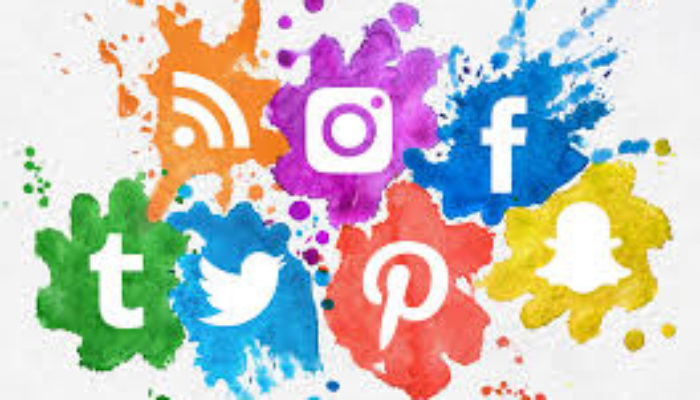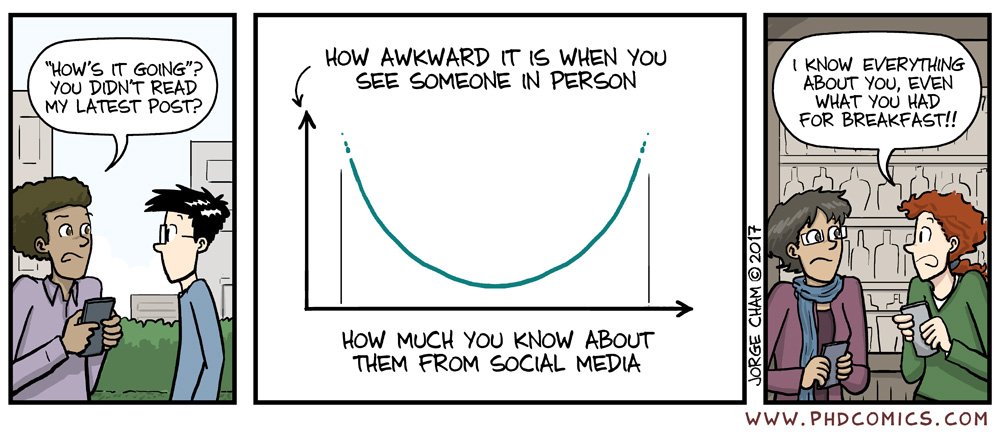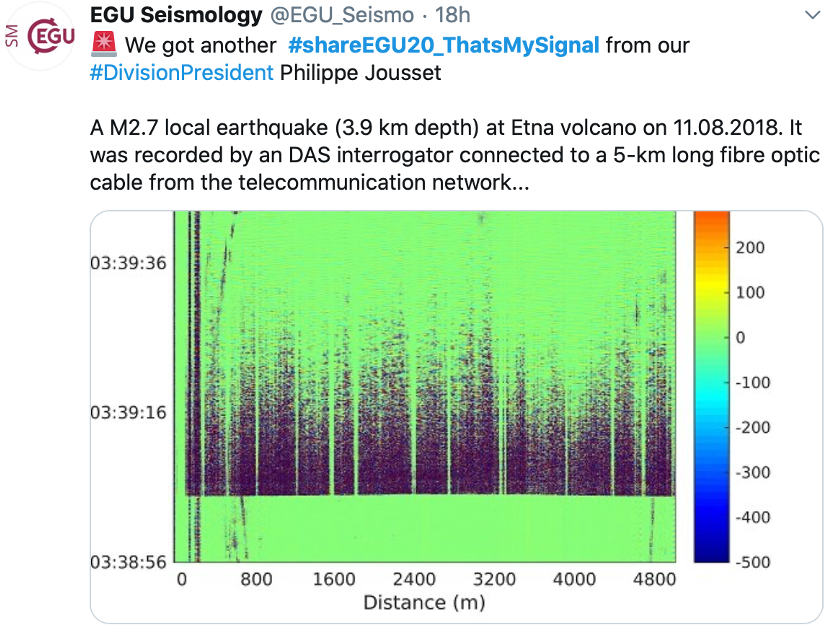
In this period of confinement, most of the virtual interactions and news about the world come from the web and mainly social media. Today, we suggest looking at social media from the point of view of an early career scientist (ECS) and why we should (or should not) use them in our career path. In the next weeks, most of the international conferences will move on online virtual meetings and social media will play a key role in our community.
Social media became a powerful tool in science to solve problems, share results, and advertise one’s research and career. The famous hashtag is entered in our habit to share our daily life with a largely unknown community. In 2009, Professor Tim Gowers from Cambridge University showed with the Polymath project the possibility to solve complex problems by using social media with collaborative work [1, 2]. Recently, a group of active geoscientists on social media showed the interest to use it to build a collaborative working group around the topic of geohazard event [3], but also about environment seismology and the effect of the COVID-19 on the seismic records [4]. All these contributions show the benefit of social media to open the scientific process to the public.
Why should ECS care?
Networking and career path
This new way of communication and interaction looks like “a tool for procrastination” for many people, but it can also be a way “to increase productivity and lead new opportunities and important connections “[2, 5].
We can be updated about the research carried out by our colleagues working on the other side of the world. We can discuss quickly the latest earthquake or eruption online, the latest published paper, the situation in the workplace (mental health, gender equality, harassment, …)[6, 7, 8] or issues that the scientific community needs to deal with (open access journal, funding, recruitment policies, …). It is also a good way to advertise one’s presentation during a conference or seminar, but also a way to share the latest results to policymakers and the public [7]. That is one of the reasons it is important to separate professional and personal social media account to maintain professionalism online.
This new way of science communication opens new career perspectives for ECS who wish to leave the academic world and its commitments, while stay connected with science. The development of mentoring online and conversations about path careers from senior scientists is another interesting point about social media interaction. Social media can help to build a social and professional network and develop new collaborations.
Crowdfunding
Another under-estimated use of social media in science is the fund-raising. Public funding is difficult to secure, and it is more difficult for ECS. Crowdfunding is an alternative [11, 15] and social media can be used in this context [11, 12, 13, 14]. For example, in 2013, a project about the impact of hydraulic fracturing on the stream ecosystem collected $10,800 in 50 days [12, 13]. In 2016, an archaeological dig covered by £25,000 from a crowdfunding project in the UK [11, 12, 14]. We will explore the topic of crowdfunding in science in another blog post in the next weeks.
Connection during an international conference:
Social media has been intensively used during this lockdown period and it became a good alternative to plan and organize a virtual social event. During the EGU General Assembly, Eric Löberich (Ph.D. Candidate at the University of Vienna), an expert in seismic anisotropy and member of the ECS representatives group, suggested replacing our usual social event by a social virtual event via the hashtag #shareEGU20_ThatsMySignal (launched on May, 6). The idea was to share on Twitter a seismic signal we are currently working on and nominate other colleagues to do the same. This experience was a good opportunity to connect together more than 30 seismologists across the world, coming from different stages of scientific careers and working on different aspects of seismology (earthquake seismology, observational seismology, environmental seismology).
Limits
Nevertheless, the main problem and challenge with social media is the amount of information we can found on it. We know that social media is rich with fake news or biased information depending on the source of information. It is often challenging to find the relevant information you are looking for and that can be time-consuming. So, if we really want to be a part of this social media community, how can we be the actors?
To address these questions, we asked 2 early-career scientists their main interests to use social media.
W.B. (Postdoc fellow in Sydney): “I started to use social medial during my Ph.D. degree in the UK to build a local geophysics community. I mainly used it to advertise jobs, latest papers, or recent earthquakes. I have recently joined the citizen-science community with the acquisition of my seismograph and post seismograms recorded regional earthquakes. Social media is useful when you want to have an overview of the latest developments or issues we deal with in our field, but also when you want to learn what’s happening outside of our own research. What I like about social media is the ability to interact with other scientists outside of our field, maybe coming from different countries. Being involved in this community can open some perspectives outside academia (science communication community) which is not something straightforward from a university degree or academia.”
E.L. (PhD Candidate in Vienna): “My interest in social media started in 2009. Back then I moved to Freiberg to study Geophysics and Geoinformatics and wanted to stay in contact with my friends from school and my fellow students from the university. During the following years, I found further aspects of different social media platforms interesting. I started using Twitter as a general short message service, but particularly in my PhD study time in Vienna and the different workshops/meetings I attended, I discovered more contacts to follow in the online seismology community and to further connect with on LinkedIn, a platform which enables you to present yourself professionally and to find new positions. As I like the ideas to spread seismology related information to the public and to further connect our community, I volunteered as Early Career Scientist co-representative and e.g. helped Lucile managing the Twitter account of the EGU Seismology Division. In the context of spreading information, I also started to use the Raspberry Shake of our institute in Vienna to contribute to citizen science by sharing earthquake-related records (thread example). Even though social media enables us to spread the news more easily, we should be always aware of the risk of misinformation, which I believe can be reduced, if experts of a certain field gain more visibility.”
To sum up, after this quick review about social medial in science and potential interest for early-career scientists, what do we need to keep in mind?
Social medial allows:
• To build and be part of a collaborative team group to solve scientific problems
• To be part of the Citizen Science community and show the scientific process to the public
• To build a social AND professional network
• To help raise money from a crowdfunding science project
If you want to be a part of this geoscientist community on social media and try it, you are welcome!
If you missed our social media activities during the EGU General Assembly 2020 via #shareEGU20_SM or sharing your signal via #shareEGU20_ThatsMySignal, it is never too late to connect with the community and extend this social event.
This blog post was written by Walid Ben Mansour
with revisions from Javier Ojeda
____________________________________________________________
References
[1] Is massively collaborative mathematics possible? https://gowers.wordpress.com/2009/01/27/is-massively-collaborative-mathematics-possible/
[2] How super connectivity is changing the way we solve problems, Thomas Malone-Superminds
[3] Rapid collaborative knowledge building via Twitter after significant geohazard events: https://www.geosci-commun-discuss.net/gc-2019-23/
[4] The sound of Covid-silence, EGU-Seismology Blog Post
[5] How to use Twitter to further your research career: https://www.nature.com/articles/d41586-019-00535-w
[6] What all those scientists on Twitter are really doing: https://www.nature.com/news/what-all-those-scientists-on-twitter-are-really-doing-1.21873
[7] How social media helps scientists get the message across: https://phys.org/news/2018-04-social-media-scientists-message.html
[8] Science and sexism: in the eye of the Twitterstorm: https://www.nature.com/news/science-and-sexism-in-the-eye-of-the-twitterstorm-1.18767
[9] How are scientists using social media in the workplace? https://www.ncbi.nlm.nih.gov/pmc/articles/PMC5061391/
[10] A scientist’s guide to social media: https://www.sciencemag.org/features/2014/02/scientists-guide-social-media
[11] Communicating science online increases interest, engagement and access to fund: http://theconversation.com/communicating-science-online-increases-interest-engagement-and-access-to-funds-122102
[12] Crowdfunding scientific research: Descriptive insights and correlates of funding success https://journals.plos.org/plosone/article?id=10.1371/journal.pone.0208384
[13] Science Crowdfunding Takes Flight: Preparing a Strategy to Get Your Research Crowdfunded https://www.enago.com/academy/science-crowdfunding-takes-flight-preparing-a-strategy-to-get-your-research-crowdfunded/
[14] Archaeologists to launch crowdfunded search for Lindisfarne monastery https://www.theguardian.com/science/2016/mar/04/archaeologists-crowdfunded-search-lindisfarne-monastery-excavation
[15] Crowdfunding Academic Research: https://www.insidehighered.com/news/2013/06/10/academic-researchers-using-crowdfunding-platforms



